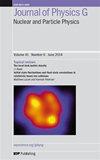Light speed variation from GRB 221009A
IF 3.4
3区 物理与天体物理
Q2 PHYSICS, NUCLEAR
Journal of Physics G: Nuclear and Particle Physics
Pub Date : 2022-10-20
DOI:10.1088/1361-6471/accebb
引用次数: 9
Abstract
It is postulated in Einstein's relativity that the speed of light in vacuum is a constant for all observers. However, the effect of quantum gravity could bring an energy dependence of light speed, and a series of studies on high-energy photon events from gamma-ray bursts (GRBs) and active galactic nuclei (AGNs) suggest a light speed variation $v(E)=c\left(1-E / E_{\mathrm{LV}}\right)$ with $E_{\mathrm{LV}}=3.6 \times 10^{17} ~\mathrm{GeV}$ or a bound $E_{\mathrm{LV}} \ge 3.6 \times 10^{17} ~\gev$. From the newly observed gamma-ray burst GRB 221009A, we find that a 99.3~GeV photon detected by Fermi-LAT is coincident with the sharp spike in the light curves detected by both Fermi-GBM and HEBS under the above scenario of light speed variation, suggesting an option that this high-energy photon was emitted at the same time as a sharp spike of low-energy photon emission at the GRB source. Thus this highest energy photon event detected by Fermi-LAT during the prompt emission of gamma-ray bursts might be considered as an optional signal for the linear form modification of light speed in cosmological space.GRB 221009A的光速变化
爱因斯坦的相对论假定真空中的光速对所有观察者来说都是恒定的。然而,量子引力效应可能带来光速的能量依赖,一系列关于伽马射线暴(GRBs)和活动星系核(agn)高能光子事件的研究表明光速变化$v(E)=c\left(1-E / E_{\mathrm{LV}}\right)$与$E_{\mathrm{LV}}=3.6 \times 10^{17} ~\mathrm{GeV}$或绑定$E_{\mathrm{LV}} \ge 3.6 \times 10^{17} ~\gev$。从新观测到的伽马射线暴GRB 221009A中,我们发现Fermi-LAT探测到的99.3 GeV光子与上述光速变化情景下Fermi-GBM和HEBS探测到的光曲线中的尖峰一致,这表明该高能光子与GRB源处低能光子发射的尖峰同时发射。因此,费米- lat在伽玛射线暴瞬发期间检测到的最高能量光子事件可以被认为是宇宙空间中光速线性形式修正的可选信号。
本文章由计算机程序翻译,如有差异,请以英文原文为准。
求助全文
约1分钟内获得全文
求助全文
来源期刊
CiteScore
7.60
自引率
5.70%
发文量
105
审稿时长
1 months
期刊介绍:
Journal of Physics G: Nuclear and Particle Physics (JPhysG) publishes articles on theoretical and experimental topics in all areas of nuclear and particle physics, including nuclear and particle astrophysics. The journal welcomes submissions from any interface area between these fields.
All aspects of fundamental nuclear physics research, including:
nuclear forces and few-body systems;
nuclear structure and nuclear reactions;
rare decays and fundamental symmetries;
hadronic physics, lattice QCD;
heavy-ion physics;
hot and dense matter, QCD phase diagram.
All aspects of elementary particle physics research, including:
high-energy particle physics;
neutrino physics;
phenomenology and theory;
beyond standard model physics;
electroweak interactions;
fundamental symmetries.
All aspects of nuclear and particle astrophysics including:
nuclear physics of stars and stellar explosions;
nucleosynthesis;
nuclear equation of state;
astrophysical neutrino physics;
cosmic rays;
dark matter.
JPhysG publishes a variety of article types for the community. As well as high-quality research papers, this includes our prestigious topical review series, focus issues, and the rapid publication of letters.

 求助内容:
求助内容: 应助结果提醒方式:
应助结果提醒方式:


